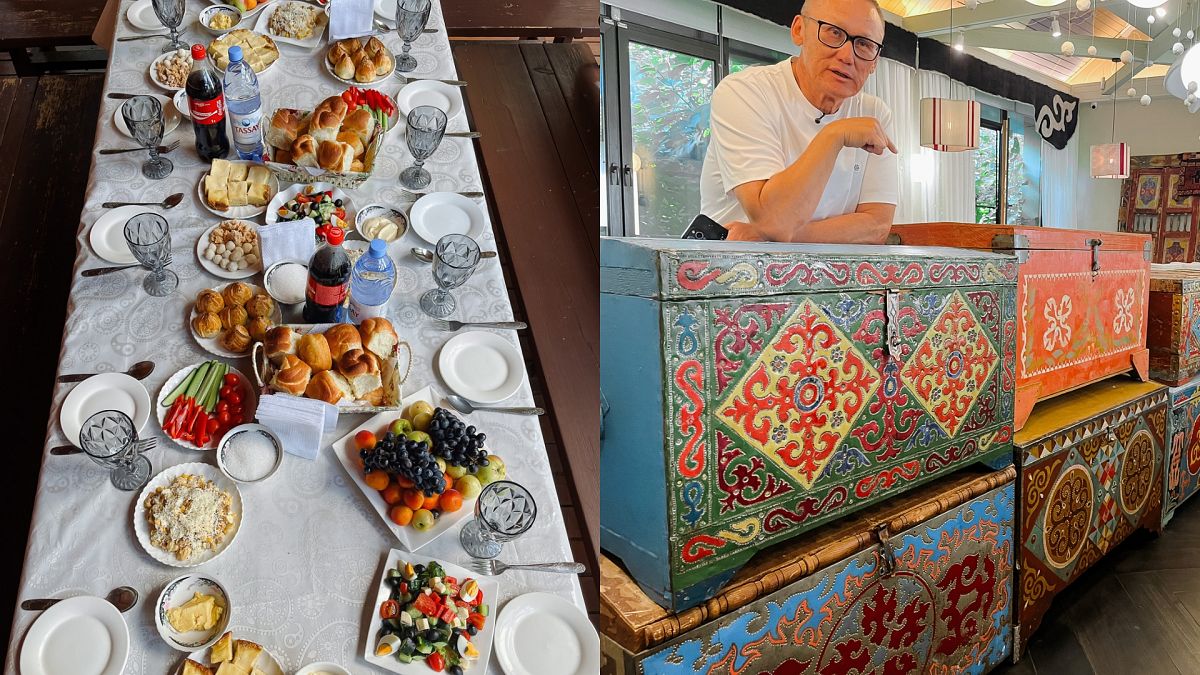ADVERTISEMENT
If you ever venture to visit Katon Karagay in the Altay mountains in Kazakhstan, which you should because it is the greenest and most tranquil national park in Kazakhstan, most knowledgeable people will tell you that you should enter through the “gate of Katon”.
The gate can be found around 400 kilometres from the picturesque mountain range and its valleys. Enough to spark my curiosity.
Katon Karagay is a region at the heart of the Altay mountain range where the borders of Kazakhstan, Russia and China meet. It is a cascade of lush green valleys in between mountains, some of which are covered with forest and some, higher ones, with glaciers.
And the “gate to Katon” is a restaurant. Its official name is Kurt & Wine, but it earned its nickname from tourists because of its unique business model.
The restaurant is situated in the eastern Kazakhstan city of Ust Kamenogorsk (or Oskemen in the Kazakh language). It is the closest place to Katon Karagay with an airport, but it is more than 400 kilometres from the Katon Karagay village.
Determined visitors land in Ust Kamenogorsk and then take a six to eight-hour ride to the natural paradise awaiting them. Many decide to stay in the city for the night, have some rest and visit the “gate” or the “base camp” as it is also called.
A cultural and historic introduction to Katon Karagay
The restaurant is decorated with artefacts from the region and modern art with traditional Kazakh motifs. Parts of yurts, traditional chests that people used to store goods and clothes in line the walls. Colourful woven belts that were once girths attaching saddles to horses now act as curtain tie-backs.
At first glance, it is impressive, but we’ve seen similar ethno restaurants all over Kazakhstan. And it still does not explain the “gate” thing.
Then we entered ‘the Room’. Most of it was occupied by a disappointingly empty massive table with odd lines and inscriptions. After the owner, Mukhtar Toybazarov, who describes himself as a historian and mountaineer, comes and greets us, we stop wishing the table were full.
“I know what they call us. I myself sometimes say we are a touristic information centre more than a restaurant,” he explains.
“They probably praise us too much, but we did try our best to explain to the tourists who come to Eastern Kazakhstan, what lies ahead of them, what they can expect on their trip.”
Leaning towards us, Mukhtar begins to tell us, first about the table itself.
“We thought for four months what to make of it, and then we were making it for two months. The lines here are rivers, the table is the map of Katon Karagay.”
The story begins with the glaciers that melt and supply rivers with water, and about the conditions in the mountains. It continues with the people who lived there, the archaeological excavations that found burial mounds from the 4th and 8th centuries BC, in which people were buried in gold-adorned clothes.
He challenges our knowledge about the Kazakhs – the ones from Katon were not real nomads, he claims – because a more moderate climate, abundance of water and lush greenery allowed them to stay in one place the whole year round. Mukthar offer another brain teaser.
“They say Kazakhstan is not connected to the sea, but you could sit in a boat in Ust Kamenogorsk and paddle all the way to the Arctic Ocean. The rivers Irtysh, created by the glaciers in Mongolia and Katun, which springs in Russia, will flow into other waters and meet in Hanty Mansysk in Russia and then fill the Northern Ocean with water. Old French maps called that ocean the Tatar ocean.”
In addition to the cultural and geographic introduction, you can get practical information at the restaurant too, including where to stay, what to see, what to avoid, what kind of car can go where (some roads in Katon are dirt or “tractor” roads) and where to get such cars.
You’ll find out where to buy famous Katon honey alongside phone numbers, destination names, and names of people to look for.
And, no, the owner did not just sit with us because we were a TV crew; he actually left us at times to go and sit with other tourists. Everyone gets briefed.
Food is still at the heart of the restaurant
Even with all of the information and resources, the restaurant is still mainly about food. The map table finally fills, and the food is made of traditional ingredients but with a modern touch.
“Our main problem was that when foreigners come, they want to eat Kazakh dishes and Kazakh cuisine is a home kitchen, it is meant for the family, not for the restaurant. You saw the main dish ‘beshparmak’ and how it comes in huge shallow bowls. We can not just put a head or bowels of an animal in front of people in a restaurant,” Mukhtar says.
“So, we found the way to save the taste and spirit, but adjust it to modern times. Take for instance, this dish with pears. The cream the pears are in is the traditional kurt (hard, dehydrated yoghurt popular across Central Asia). You’d never guess.
“We grind it, add some liquid and blow air into it and we get this mousse. And that mousse goes well with fruit, pears, strawberries and with meat. But it is still the kurt taste”.
Baursaks (Central Asian doughnuts) also came in the shape I had never seen them in before – sliced in half, dipped into milk cream and laced with a kind of local caviar and herbs.
Lamb chops were marinated and roasted for 11 hours, and horse meat was raw, just smoked. Still, it was as tender as the lamb. The most traditional part was the bread, hot from the oven, that our host tears with his hands and gives a piece to all of us.
“My grandmother and my mother used to bake bread like this. We have just taken it from the special oven (kazan) so that you can taste it hot and fresh. It is our custom that the host gives the bread to everyone from his own hand,” he says.
We parted well informed and better prepared for the long trip ahead of us, but we did not ask about the danger currently hanging over the restaurant. Its future could be limited as the region expands travel options to attract more visitors.
In order to make Katon more accessible to tourists and save them a lengthy trip from Ust Kamenogorsk, the government is building a new international airport in Katon. It should open next year. It means that in the future, tourists may get there by flying over the “gate”.













